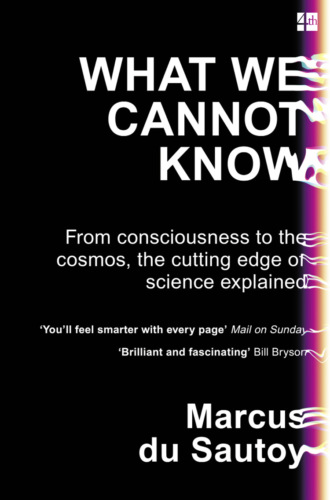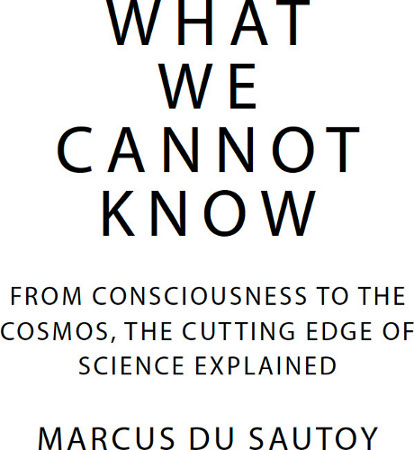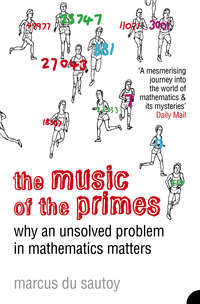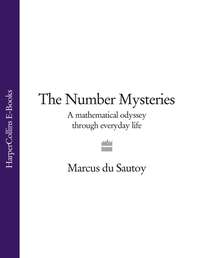
Полная версия
What We Cannot Know: Explorations at the Edge of Knowledge



Copyright

4th Estate
An imprint of HarperCollinsPublishers
1 London Bridge Street
London SE1 9GF
www.4thestate.co.uk
First published in Great Britain by 4th Estate in 2016
This 4th Estate paperback edition 2017
Copyright © Marcus du Sautoy 2016
Cover design © Jonathan Pelham
The right of Marcus du Sautoy to be identified as the author of this work has been asserted by him in accordance with the Copyright, Designs and Patents Act 1988
A catalogue record for this book is available from the British Library
All rights reserved under International and Pan-American Copyright Conventions. By payment of the required fees, you have been granted the non-exclusive, non-transferable right to access and read the text of this e-book on-screen. No part of this text may be reproduced, transmitted, down-loaded, decompiled, reverse engineered, or stored in or introduced into any information storage and retrieval system, in any form or by any means, whether electronic or mechanical, now known or hereinafter invented, without the express written permission of HarperCollins.
Source ISBN: 9780007576593
Ebook Edition © 2017 ISBN: 9780007576579
Version: 2017-04-01
Dedication
To my parents, who started me on my journey to the edges of knowledge
CONTENTS
Cover
Title Page
Copyright
Dedication
Edge Zero: The Known Unknowns
First Edge: The Casino Dice
Chapter 1
Chapter 2
Second Edge: The Cello
Chapter 3
Chapter 4
Third Edge: The Pot of Uranium
Chapter 5
Chapter 6
Fourth Edge: The Cut-Out Universe
Chapter 7
Chapter 8
Fifth Edge: The Wristwatch
Chapter 9
Chapter 10
Sixth Edge: The Chatbot App
Chapter 11
Chapter 12
Seventh Edge: The Christmas Cracker
Chapter 13
Chapter 14
Further Reading
Index
Acknowledgements
Illustration Credits
Also by Marcus du Sautoy
About the Publisher
EDGE ZERO: The Known Unknowns
Everyone by nature desires to know.
Aristotle, Metaphysics
Science is king.
Every week, headlines announce new breakthroughs in our understanding of the universe, new technologies that will transform our environment, new medical advances that will extend our lives. Science is giving us unprecedented insights into some of the big questions that have challenged humanity ever since we’ve been able to formulate those questions. Where did we come from? What is the ultimate destiny of the universe? What are the building blocks of the physical world? How does a collection of cells become conscious?
In the last ten years alone we’ve landed a spaceship on a comet, made robots that can create their own language, used stem cells to repair the pancreas of diabetic patients, discovered how to use the power of thought alone to manipulate a robotic arm, sequenced the DNA of a 50,000-year-old cave girl. Science magazines are bursting with the latest breakthroughs emerging from the world’s laboratories. We know so much. The advances of science are extremely intoxicating.
Science has given us our best weapon in our fight against fate. Instead of giving in to the ravages of disease and natural disaster, science has created vaccines to combat deadly viruses like polio and even ebola. Faced with an escalating world population, it is scientific advances that provide the best hope of feeding the 9.6 billion people who are projected to be alive in 2050. It is science that is warning us about the deadly impact we are having on our environment and giving us the chance to do something about it before it is too late. An asteroid might have wiped out the dinosaurs, but the science that humans have developed is our best shield against any future direct hits. In the human race’s constant battle with death, science is its best ally.
Science is king not only when it comes to our fight for survival but also in improving our quality of life. We are able to communicate with friends and family across vast distances. We have unparalleled access to the database of knowledge we have accumulated over generations of investigation. We have created virtual worlds that we can escape to in our leisure time. We can recreate in our living rooms the great performances of Mozart, Miles and Metallica at the press of a button.
That desire to know is programmed into the human psyche. Those early humans with a thirst for knowledge are those who have survived, adapted, transformed their environment. Those not driven by that craving were left behind. Evolution has favoured the mind that wants to know the secrets of how the universe works. The adrenaline rush that accompanies the discovery of new knowledge is nature’s way of telling us that the desire to know is as important as the drive to reproduce. As Aristotle articulated in the opening line of his book Metaphysics, understanding how the world works is a basic human need.
As a schoolkid, science very quickly drew me into its outstretched arms. I fell in love with its extraordinary power to tell us so much about the universe. The fantastic stories that my science teachers told seemed even more fanciful than the fiction I’d been reading at home. As it worked its spell on me I consumed every outlet of science I could get my hands on.
I persuaded my parents to buy me a subscription to New Scientist. I devoured Scientific American in our local library. I hogged the television each week to watch episodes of my favourite science programmes: Horizon and Tomorrow’s World. I was captivated by Jacob Bronowski’s Ascent of Man, Carl Sagan’s Cosmos, Jonathan Miller’s Body in Question. Every Christmas the Royal Institution Christmas Lectures provided a good dollop of science alongside our family turkey. My stocking was stuffed with books by Gamow and Feynman. It was a heady time, with new breakthroughs being announced each week.
Alongside reading these stories of the discovery of things we know, I began to get more fired up by the untold tales. What we knew lay in the past but what we didn’t yet know was the future, my future. I became obsessed with the puzzle books of mathematician Martin Gardner that my maths teacher gave me. The excitement of wrestling with a conundrum and the sudden release of euphoria as I cracked each puzzle got me addicted to the drug of discovery. Those puzzles were my training ground for the greater challenge of tackling questions that didn’t have an answer in the back of the book. It was the unanswered questions, the mathematical mysteries and scientific puzzles that no one had cracked that would become the fuel for my life as a scientist.
WHAT WE KNOW
If I look back to the Seventies when I was at school and compare the things that we knew then to what we know now, it is quite extraordinary how much more we have understood about the universe even in the half century that I’ve been alive. Technology has extended our senses so we can see things that were beyond the conception of the scientists who excited me as a kid.
The new range of telescopes that look out at the night sky have discovered planets like the Earth that could be home to intelligent life. They have revealed the amazing fact that three-quarters of the way into the lifetime of our universe the expansion of the universe started to accelerate. I remember reading as a kid that we were in for a big crunch, but now it seems that we have a completely different future waiting for us.
The particle colliders like the Large Hadron Collider at CERN (the European Organization for Nuclear Research in Switzerland) have allowed us to penetrate the inner workings of matter itself, revealing new particles – like the top quark discovered in 1994 and the Higgs boson discovered in 2012 – that were bits of speculative mathematics when I was reading my New Scientist at school.
And since the early Nineties the fMRI scanner has allowed us to look inside the brain and discover things that in the Seventies were frankly not even considered part of the remit of scientists. The brain was the preserve of philosophers and theologians, but today the technology can reveal when you are thinking about Jennifer Aniston or predict what you are going to do next even before you know.
Biology has seen an explosion of breakthroughs. In 2003 it was announced that scientists had mapped one whole human DNA sequence consisting of 3 billion letters of genetic code. In 2011 the complete neuronal network of the C. elegans worm was published, providing a complete picture of how the 302 neurons in the worm are connected.
Chemists too have been breaking new territory. A totally new form of carbon was discovered in 1985, which binds together like a football, and chemists surprised us again in 2003 by creating the first examples of graphene, showing how carbon can form a honeycomb lattice one atom thick.
And in my lifetime the subject to which I would eventually dedicate myself, mathematics, has seen some of the great enigmas finally resolved: Fermat’s Last Theorem and the Poincaré conjecture, two challenges that had outfoxed generations of mathematicians. New mathematical tools and insights have opened up hidden pathways to navigate the mathematical universe.
Keeping up with all these new advances, let alone making your own contribution, is a challenge in its own right.
THE KNOW-IT-ALL PROFESSORSHIP
A few years ago I got a new job title to add to my role as a professor of mathematics at the University of Oxford. It often makes me laugh: the Simonyi Professor for the Public Understanding of Science. There seems to be a belief that with such a title I should know it all. People ring me up expecting that I know the answers to every question of science. Shortly after I’d taken on the job, the Nobel Prize for medicine was announced. A journalist called, hoping for an explanation of the breakthrough that was being rewarded: the discovery of telomeres.
Biology has never been my strong point, but I was sitting in front of my computer screen and so I’m embarrassed to admit I got the Wikipedia page up on telomeres and, after a quick scan, proceeded to explain authoritatively that they are the bit of genetic code at the end of our chromosomes that controls ageing among other things. The technology we have at our fingertips has increased that sense that we have the potential to know anything. Just tap my question into a search engine and the device seems to predict, even before I’ve finished typing, what it is I want to know and provides a list of places to find the answer.
But understanding is different from a list of facts. Is it possible for any scientist to know it all? To know how to solve non-linear partial differential equations? To know how SU(3) governs the connection between fundamental particles? To know how cosmological inflation gives rise to the state of the universe? To know how to solve Einstein’s equations of general relativity or Schrödinger’s wave equation? To know how neurons and synapses trigger thought? Newton, Leibniz and Galileo were perhaps the last scientists to know all that was known.
I must admit that the arrogance of youth infused me with the belief that I could understand anything that was known. If someone’s human brain out there has found a way to navigate a path to new knowledge, then if the proof works in their brain it should work in mine. With enough time, I thought, I could crack the mysteries of mathematics and the universe, or at least master the current lie of the land. But increasingly I am beginning to question that belief, to worry that some things will forever remain beyond my reach. Often my brain struggles to navigate the science we currently know. Time is running out to know it all.
My own mathematical research is already pushing the limits of what my human brain feels capable of understanding. I have been working for over ten years on a conjecture that remains stubbornly resistant to my attempts to crack it. But my new role as the Professor for the Public Understanding of Science has pushed me outside the comfort zone of mathematics into the messy concepts of neuroscience, the slippery ideas of philosophy, the unfounded theories of physics. It has required a different way of thinking that is alien to my mathematical mode of thought, which deals in certainties, proofs and precision. My attempts to understand everything that is currently regarded as scientific knowledge has severely tested the limits of my own ability to understand.
The process of attaining knowledge necessarily relies on our standing on the shoulders of giants, as Newton famously declared about his own breakthroughs. And so my own journey to the edges of knowledge has involved reading how others have articulated the current state of knowledge, listening to lectures and seminars by those immersed in the field I’m trying to understand, talking to those pushing the boundaries, questioning contradictory stories, consulting the evidence and data recorded in the scientific journals that support a theory, even at times looking up an idea on Wikipedia. Although we teach students to question any information that pops up from a Google search, research has revealed that Wikipedia’s accounts of topics at the less controversial end of the scientific spectrum, like the theory of general relativity, are regarded as on a par with accounts in the scientific literature. Choose a more contested issue, like climate change, and the content might depend on what day you look.
This raises the question of how much can you trust any of these stories. Just because the scientific community accepts a story as the current best fit, this doesn’t mean it is true. Time and again, history reveals the opposite to be the case, and this must always act as a warning that current scientific knowledge is provisional. Mathematics perhaps has a slightly different quality, as I will discuss in the final two chapters. Mathematical proof provides the chance to establish a more permanent state of knowledge. But it’s worth noting that even when I am creating new mathematics, I will often quote results by fellow mathematicians whose proofs I won’t have checked myself. To do so would mean running in order to keep still.
And for any scientist the real challenge is not to stay within the secure garden of the known but to venture out into the wilds of the unknown. That is the challenge at the heart of this book.
WHAT WE DON’T KNOW
Despite all the breakthroughs made in science over the last centuries, there are still lots of deep mysteries waiting out there for us to solve. Things we don’t know. The knowledge of what we are ignorant of seems to expand faster than our catalogue of breakthroughs. The known unknowns outstrip the known knowns. And it is those unknowns that drive science. A scientist is more interested in the things he or she can’t understand than in telling all the stories we already know how to narrate. Science is a living, breathing subject because of all those questions we can’t answer.
For example, the stuff that makes up the physical universe we interact with seems to account for only 4.9% of the total matter content of our universe. So what is the other 95.1% of so-called dark matter and dark energy made up of? If our universe’s expansion is accelerating, where is all the energy coming from that is fuelling that acceleration?
Is our universe infinite? Are there infinitely many other infinite universes parallel to our own? If there are, do they have different laws of physics? Were there other universes before our own universe emerged from the Big Bang? Did time exist before the Big Bang? Does time exist at all or does it emerge as a consequence of more fundamental concepts?
Why is there a layer of fundamental particles with another two almost identical copies of this layer but with increasing mass, the so-called three generations of fundamental particles? Are there yet more particles out there for us to discover? Are fundamental particles actually tiny strings vibrating in 11-dimensional space?
How can we unify Einstein’s theory of general relativity, the physics of the very large, with quantum physics, the physics of the very small? This is the search for something called quantum gravity, an absolute necessity if we are ever going to understand the Big Bang, when the universe was compressed into the realm of the quantum.
And what of the understanding of our human body, something so complex that it makes quantum physics look like a high-school exercise. We are still trying to get to grips with the complex interaction between gene expression and our environment. Can we find a cure for cancer? Is it possible to beat ageing? Could there be someone alive today who will live to be a 1000 years old?
And what about where humans came from? Evolution is a process of random mutations, so would a different roll of the evolutionary dice still produce organisms with eyes? If we rewound evolution and pressed ‘play’, would we get intelligent life, or are we the result of a lucky roll of the dice? Is there intelligent life elsewhere in our universe? And what of the technology we are creating? Can a computer ever attain consciousness? Will I eventually be able to download my consciousness so that I can survive the death of my body?
Mathematics too is far from finished. Despite popular belief, Fermat’s Last Theorem was not the last theorem. Mathematical unknowns abound. Are there any patterns in prime numbers or are they outwardly random? Will we be able to solve the mathematical equations for turbulence? Will we ever understand how to factorize large numbers efficiently?
Despite so much that is still unknown, scientists are optimistic that these questions won’t remain unanswered forever. The last few decades give us reason to believe that we are in a golden age of science. The rate of discoveries in science appears to grow exponentially. In 2014 the science journal Nature reported that the number of scientific papers published has been doubling every nine years since the end of the Second World War. Computers too are developing at an exponential rate. Moore’s law is the observation that computer processing power seems to double every two years. Engineer Ray Kurzweil believes that the same applies to technological progress: that the rate of change of technology over the next 100 years will be comparable to what we’ve experienced in the last 20,000 years.
And yet can scientific discoveries maintain this exponential growth? Kurzweil talks about the Singularity, a moment when the intelligence of our technology will exceed our human intelligence. Is scientific progress destined for its own singularity? A moment when we know it all. Surely at some point we might actually discover the underlying equations that explain how the universe works. We will discover the final list of particles that make up the building blocks of the physical universe and how they interact with each other. Some scientists believe that the current rate of scientific progress will lead to a moment when we might discover a theory of everything. They even give it a name: ToE.
As Hawking declared in A Brief History of Time: ‘I believe there are grounds for cautious optimism that we may be near the end of the search for the ultimate laws of nature’, concluding dramatically with the provocative statement that then ‘we would know the mind of God’.
Is such a thing possible? To know everything? Would we want to know everything? Science would ossify. Scientists have a strangely schizophrenic relationship with the unknown. On the one hand, it is what we don’t know that intrigues and fascinates us, and yet the mark of success as a scientist is resolution and knowledge, to make the unknown known.
Could there be some quests that will never be resolved? Are there limits to what we can discover about our physical universe? Are some regions of the future beyond the predictive powers of science and mathematics? Is time before the Big Bang a no-go area? Are there ideas so complex that they are beyond the conception of our finite human brains? Can brains even investigate themselves, or does the analysis enter an infinite loop from which it is impossible to rescue itself? Are there mathematical conjectures that can never be proved true?
WHAT WE’LL NEVER KNOW
What if there are questions of science that can never be resolved? It seems defeatist, even dangerous, to admit there may be any such questions. While the unknown is the driving force for doing science, the unknowable would be science’s nemesis. As a fully signed-up member of the scientific community, I hope that we can ultimately answer the big open questions. So it seems important to know if the expedition I’ve joined will hit boundaries beyond which we cannot proceed. Questions that won’t ever get closure.
That is the challenge I’ve set myself in this book. I want to know if there are things that by their very nature we will never know. Are there things that will always be beyond the limits of knowledge? Despite the marauding pace of scientific advances, are there things that will remain beyond the reach of even the greatest scientists? Will there remain mysteries that will resist our attempts to lift the veils that currently mask our view of the universe?
It is, of course, very risky at any point in history to try to articulate Things We Cannot Know. How can you know what new insights are suddenly going to pull the unknown into the knowable? This is partly why it is useful to look at the history of how we know the things we do, because it reveals how often we’ve been at points where we think we have hit the frontier, only to find some way across.
Take the statement made by French philosopher Auguste Comte in 1835 about the stars: ‘We shall never be able to study, by any method, their chemical composition or their mineralogical structure.’ An absolutely fair statement given that this knowledge seemed to depend on our visiting the star. What Comte hadn’t factored in was the possibility that the star could visit us, or at least that photons of light emitted by the star could reveal its chemical make-up.
A few decades after Comte’s prophecy, scientists had determined the chemical composition of our own star, the Sun, by analysing the spectrum of light emitted. As the nineteenth-century British astronomer Warren de la Rue declared: ‘If we were to go to the Sun, and to bring some portions of it and analyse them in our laboratories, we could not examine them more accurately than we can by this new mode of spectrum analysis.’







